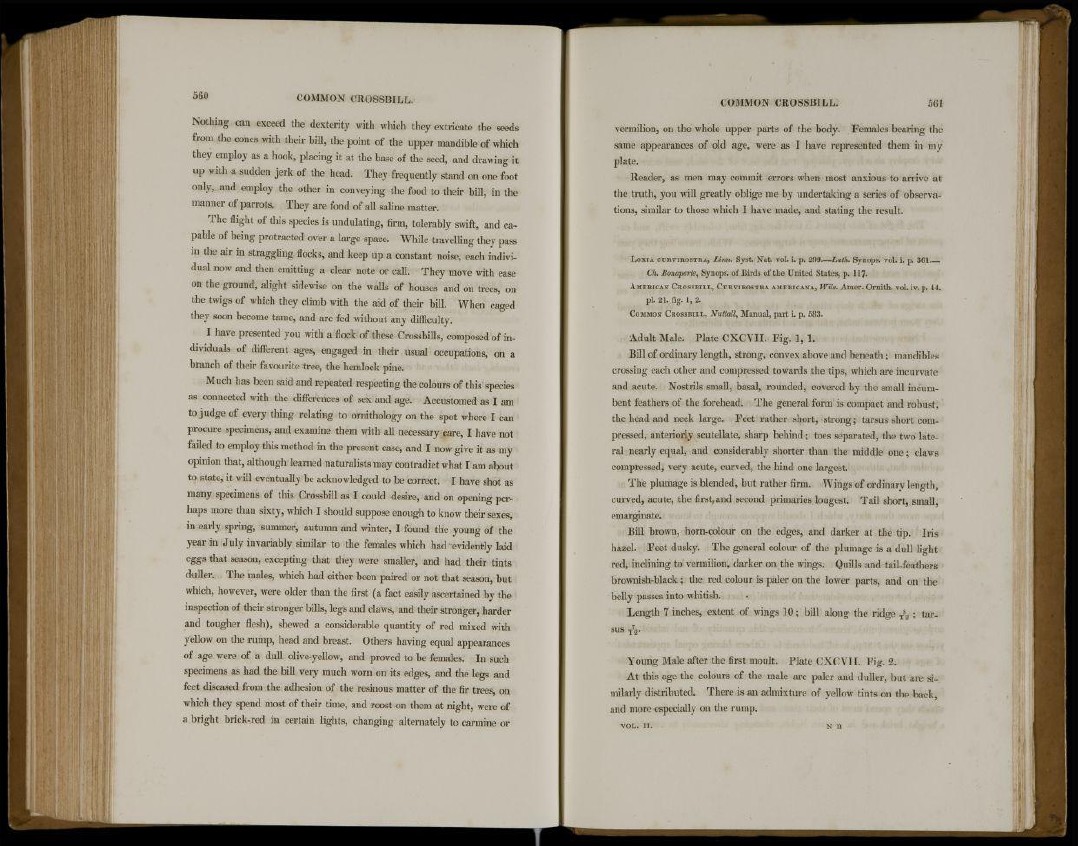
560 COMMON CROSSBILL,
Nothing can exceed the dexterity with which they extricate the seeds
from the cones with their bill, the point of the upper mandible of which
they employ as a hook, placing it at the base of the seed, and drawing it
up with a sudden jerk of the head. They frequently stand on one foot
only, and employ the other in conveying the food to their bill, in the
manner of parrots. They are fond of all saline matter.
The flight of this species is undulating, firm, tolerably swift, and capable
of being protracted over a large space. While travelling they pass
in the air in straggling flocks, and keep up a constant noise, each individual
now and then emitting a clear note or call. They move with ease
on the ground, alight sidewise on the walls of houses and on trees, on
the twigs of which they climb with the aid of their bill. When caged
they soon become tame, and are fed without any difficulty.
I have presented you with a flock of these Crossbills, composed of individuals
of different ages, engaged in their usual occupations, on a
branch of their favourite tree, the hemlock pine.
Much has been said and repeated respecting the colours of this species
as connected with the differences of sex and age. Accustomed as I am
to judge of every thing relating to ornithology on the spot where I can
procure specimens, and examine them with all necessary care, I have not
failed to employ this method in the present case, and I now give it as my
opinion that, although learned naturalists may contradict what I am about
to state, it will eventually be acknowledged to be correct. I have shot as
many specimens of this Crossbill as I could desire, and on opening perhaps
more than sixty, which I should suppose enough to know their sexes,
in early spring, summer, autumn and winter, I found the young of the
year in July invariably similar to the females which had evidently laid
eggs that season, excepting that they were smaller, and had their tints
duller. The males, which had either been paired or not that season, but
which, however, were older than the first (a fact easily ascertained by the
inspection of their stronger bills, legs and claws, and their stronger, harder
and tougher flesh), shewed a considerable quantity of red mixed with
yellow on the rump, head and breast. Others having equal appearances
of age were of a dull olive-yellow, and proved to be females. In such
specimens as had the bill very much worn on its edges, and the legs and
feet diseased from the adhesion of the resinous matter of the fir trees, on
which they spend most of their time, and roost on them at night, were of
a bright brick-red in certain lights, changing alternately to carmine or
COMMON CROSSBILL. 561
vermilion, on the whole upper parts of the body. Females bearing the
same appearances of old age, were as I have represented them in my
plate.
Reader, as men may commit errors when- most anxious to arrive at
the truth, you will greatly oblige me by undertaking a series of observations,
similar to those which I have made, and stating the result.
LOXIA CURVIROSTRA, Linn. Syst. Nat. vol. i. p. 299—Lath. Synops. vol. i. p. 3G1—
Ch. Bonaparte, Synops. of Birds of the United States, p. 117.
AMERICAN CROSSBILL, CURVIROSTRA AMERICANA, Wits. Amer. Ornith. vol. iv. p. 44.
pi. 21. fig. 1, 2.
COMMON CROSSBILL, Nuttall, Manual, part L p. 583.
Adult Male. Plate CXCVII. Fig. 1, 1.
Bill of ordinary length, strong, convex above and beneath; mandibles
crossing each other and compressed towards the tips, which are mcurvate
and acute. Nostrils small, basal, rounded, covered by the small incumbent
feathers of the forehead. The general form is compact and robust,
the head and neck large. Feet rather short, strong; tarsus short compressed,
anteriorly scutellate, sharp behind; toes separated, the two lateral
nearly equal, and considerably shorter than the middle one; claws
compressed, very acute, curved, the hind one largest.
The plumage is blended, but rather firm. Wings of ordinary length,
curved, acute, the firsthand second primaries longest. Tail short, small,
emarginate.
Bill brown, horn-colour on the edges, and darker at the tip. Iris
hazel. Feet dusky. The general colour of the plumage is a dull light
red, inclining to vermilion, darker on the wings. Quills and tail-feathers
brownish-black; the red colour is paler on the lower parts, and on the
belly passes into whitish.
Length 7 inches, extent of wings 10; bill along the ridge T
8
g ; tarsus
T
7
2 .
Young Male after the first moult. Plate CXCVII. Fig. 2.
At this age the colours of the male are paler and duller, but are similarly
distributed. There is an admixture of yellow tints on the back,
and more especially on the rump.
VOL. II. N n